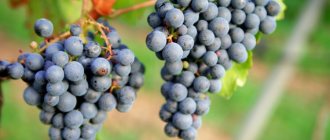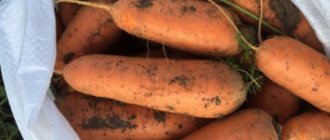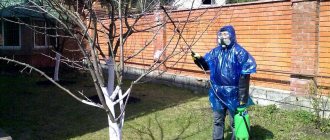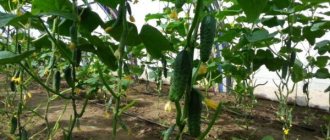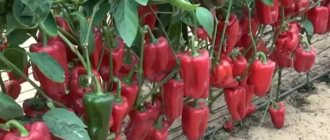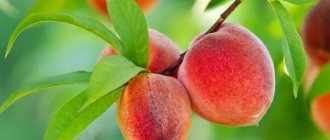Included in the top ten “Tairov” grape varieties, “Lora” (more precisely “Flora”) is very popular in amateur cultivation in Ukraine and southern Russia due to its exquisite bouquet of noble taste of berries and early ripening.
The “Lora” grape (pictured) pleases amateur gardeners with the yield, marketability and taste of the fruit
According to Ukrainian experts and reviews from experienced winegrowers from different regions of our country, the main characteristic features of the variety can be identified:
| Parameter | Characteristic |
| Culture | Grapes (Vitis Vinifera L.) |
| Variety | "Flora" ("Lora") |
| Direction of use | Dining room |
| Flower type | Functionally feminine |
| Bush growth vigor | Average |
| Ripening time | Early ripening: first ten days of August – early September (110-115 days from the beginning of the growing season) |
| Consumption period (fruit shelf life) | Summer (autumn); in the refrigerator for more than 2 months |
| Precociousness | For the 4th year |
| Productivity of one bush per season | High: about 25 kg (maximum – 28-30 kg); in industrial plantings up to 13.8 t/ha |
| Bunch shape and weight | Large, about 40 cm long. Cylindrical-conical, medium-dense or loose (depending on pollination). Weight on average 400-700 g, maximum - over 1 kg |
| External features of berries | Large, oval, light green or amber. Firmly attached to the stalk. The skin is dense, cannot be felt when eating, dry, covered with a milky-white thin layer of waxy coating (pruin) |
| Fruit weight | From 6 to 10 g |
| Pulp | Meaty, juicy, dense, crispy |
| Tasting assessment (taste qualities) | 9.1 points (out of 10) – the taste is sweet, pleasant, harmonious |
| Sustainability | To mildew (3 points); practically not damaged by gray rot; susceptible to oidium and black spot |
| Winter hardiness | Relatively high: after frosts −21… −23 ℃ bud break 80% |
| Year of registration in the Register of Plant Varieties of Ukraine | 2008 |
| Recommended growing regions | Steppe zones |
| Originator | National Scientific Ukrainian Academy of Agrarian Sciences (Odessa) |
| Registration in the State Register of the Russian Federation | Absent |
History of selection
The Laura grape is known to most farmers and gardeners under the name Flora. It is under this name that the fruit crop is included in state registers. The Laura grape variety was bred by Odessa scientific breeders from the Institute of Viticulture named after. Tairova. To obtain a new fruit crop, 5 different grape varieties were used as pollinators.
As a result of crossing, scientists obtained a unique berry crop that absorbed the best characteristics of the mother grape varieties.
Review of reviews on cultivation and use
Laura grapes, reviews of which are mostly positive, are very popular among experienced and novice winegrowers.
Thanks to its amazing taste, rich harvest and beautiful appearance, gardeners have been cultivating this species for years. Some consumers are not satisfied with the need to constantly monitor the number of bunches, of which there should be about 6-7 per fruit shoot. However, if you follow all the rules of care, the vineyard will delight you with powerful large tassels up to 2 kg. Even the first “signal” bunches look very decent.
It is important that this species is not afraid of cold weather, like other elite varieties. But experienced winegrowers still advise insulating it for the winter.
Gardeners consider the biggest drawback of “lora” to be that it is much more susceptible to wasp damage than other varieties of grapes.
Description and features
Laura grapes have their own varietal characteristics that affect the rules of care, cultivation and yield.
Grape bushes
Fast-growing, medium-sized grape bushes with a large number of fruiting shoots.
The main trunk is strong and powerful with grayish bark and brown twigs. The leaf blades are large, smooth, rich green in color and have serrated edges.
The grape clusters are dense, massive, cone-shaped, weighing from 700 to 1000 g.
Advice! A large number of fruiting shoots must be controlled and the load on the grape bush reduced. In this case, the bunches will increase their weight to 2 kg.
Berries
The ripened fruits of the Laura grape variety are distinguished by their attractive presentation, excellent taste and beneficial properties.
The berries are large, weighing up to 12 g, elongated, with a dense green-white shell and a protective coating, sometimes a pink blush appears on the sunny side. Each berry contains several grains that are easily separated from the pulp.
Resistance
Thanks to many years of work by scientists, the berry crop of the Flora variety has become resistant to damage by diseases, pests and climatic conditions.
Pollination
To obtain a harvest of tasty and healthy berries, the hybrid variety Flora requires pollination. In a fruit crop, only female flowers bloom during the flowering period, so other grape varieties with the same flowering periods are planted nearby, or pollination is carried out manually.
Advice! The best pollinators for Laura grapes are the Kishmish radiant or Arcadia varieties.
Ripening period
The timing of berry ripening directly depends on proper care, pruning and climatic conditions of the growing region.
The berry bush enters the active flowering phase in May.
According to the data stated in the characteristics of the variety, fruit ripening occurs on days 110-115 after the formation of ovaries.
But there are several reasons why crop ripening may be accelerated or delayed.
- A large number of fruiting shoots. If the number of clusters on a bush exceeds 30 units, then the grapes ripen much longer.
- In the southern regions, berries ripen 10-14 days earlier than in the middle zone.
- If there are few clusters on a grape bush, then the ripening period begins in early August, which is fraught with the formation of new ovaries in early autumn.
The recommended number of bunches on an adult grape bush is from 23 to 28.
Laura grapes: variety description
The shoots have an average growth rate, the bushes are of medium size.
The volume of fruitful shoots is from 60 to 80% of the total. The clusters are conical in shape, weighing on average over 1 kg, maximum - up to 2.5 kg. They reach 40 cm in length. The density can be loose or medium.
The quality of flower pollination and the vigor of the plant as a whole have a serious impact on the density and weight of the bunches. Almost identical clusters usually develop on the bush, differing little from each other in size and weight.
The leaves have a not pronounced five-lobed shape, the ends are dissected, and the color of the outer surface is dark green.
The berries are oval, oblong or cylindrical, the weight of each varies from 7 to 10 g. They reach 3-4 cm in length.
The size can increase in the presence of a tall rootstock, which reduces the taste properties and increases the ripening period. The berry is well attached to the stalk and does not fall off for a long time.
The flesh is crispy and strong. It has a pleasant taste with a hint of nutmeg, and is distinguished by a balance between acidity and sugar content. The amount of sugar is from 20%, acid is 6-8 g per liter.
The sweetness of the fruit decreases with high soil and air humidity, especially in cool weather, as well as in the presence of a tall rootstock. The seeds are large and hard.
Main characteristics of the variety
The declared varietal properties and characteristics may vary depending on climatic weather changes, the place where the seedlings are planted and the quality of care for the berry crop.
Taste qualities
The taste of ripe berries is the main advantage of Flora grapes.
Large, crispy fruits with juicy, sweet pulp and a nutmeg aftertaste.
The balanced content of sugars in the berries up to 20% and acids up to 9 g/l makes the fruits attractive both for fresh consumption and for the production of various types of wines.
Frost resistance
When breeding the Laura variety, breeders achieved increased frost resistance of the fruit crop. Grape bushes can easily tolerate frosts down to -27 degrees, which makes it possible to grow berry bushes even in low temperatures.
Productivity
Fruiting of grape bushes begins at 2-3 years of growth in open ground. With proper and timely care, up to 35 kg of berries are obtained from one plant, and with additional strengthening of fruit-bearing shoots, the yield increases to 50 kg per bush.
Adaptation
Due to its resistance to low temperatures, diseases and pests, the grape variety is cultivated in various climatic conditions. Both southern latitudes and regions with a temperate climate are suitable for growing fruit crops.
Important! High humidity and heavy rain reduce the taste and yield of grapes.
Resistance to diseases and pests
When developing the Laura variety, special attention was paid to resistance to diseases and pests. Although grapes have received natural immunity, powdery mildew and black mold often affect the fruit crop.
Transportation and storage
Ripe bunches retain their presentation on the bushes for a long time; the berries do not dry out, do not spoil or fall off. The harvested grapes, due to their thick skin, are stored for a long time and transported over long distances.
Useful properties of berries
Grape berries contain a huge amount of vitamins, micro and macroelements, fructose, glucose, amino acids, pectins, flavonoids and fiber.
The fruits are used for the treatment and prevention of colds and cardiovascular diseases. Berries help the functioning of the gastrointestinal tract, replenish the body's supply of nutrients and beneficial substances, have a calming effect, and are recommended for stress and depression.
See also
The best ways to feed grapes in July to improve fruiting
Read
Also, grapes are used for the production of perfumes and cosmetics.
Growing
It is possible to grow Laura grapes both on an industrial scale and in home vineyards.
To protect the plants from the wind, it is recommended to plant them near dense trees or outbuildings.
Planting period
It is best to plant seedlings of the crop in the spring, when the soil warms up to a temperature of ten degrees. As a rule, this period of time falls on mid-April-early May (depending on the planting region). In order for the procedure to be completed successfully, it is recommended to use the following rules:
- the site should be selected at an elevation to avoid excess water during precipitation;
- the bushes of the crop must receive sunlight and heat, so the place must be well lit;
- It is recommended to choose the lightest and most well-drained soil;
- It is better to locate the vineyard on the south side.
Ripening time
The variety is classified as an early ripening variety, but even for this category the ripening time can be considered too short. Thus, the first harvest can be obtained just one hundred and ten days after the start of the growing season. Sweeter berries, as a rule, ripen towards the end of the season, on the one hundred and twentieth day.
The grapes are characterized by early ripening of clusters - a maximum of 120 days.
For southern latitudes, early ripening is beneficial, but in colder regions it is important to protect the grapes in the spring from possible frosts.
Advantages and disadvantages
In order to properly grow a fruit crop, it is necessary to find out all the advantages and disadvantages of the Laura grape variety.
Advantages:
- Early fruit ripening.
- Resistance to the climatic conditions of the growing region.
- High yields.
- Easy to care for.
- Excellent taste of berries.
- The fruits do not fall off the bushes, are stored for a long time and tolerate long-distance transportation well.
With proper care and competent agricultural technology, the yield of Flora grapes increases many times.
Flaws:
- High humidity and precipitation have a negative impact on the taste and ripening time of berries.
- The variety is often affected by powdery mildew.
- Pollination is necessary for harvesting.
- Instability of fruiting.
- Due to their sweet taste and nutmeg aroma, the berries are susceptible to attack by wasps.
- The larger the bunches of grapes, the worse the taste of the berries.
But even such difficulties in growing fruit crops do not prevent gardeners and farmers from receiving abundant harvests of tasty, juicy, and most importantly healthy berries.
Reviews
Tamara, Krasnodar region I grow several bushes of Laura, the vine ripens quickly, there are a lot of clusters, the berries are large and tasty. Wasps have become addicted to these grapes, I hang traps with jam and nets on the tassels to help keep pests away.
Mikhail, Novorossiysk I have been growing the Laura variety for five years, the bushes are powerful, the survival rate is good, the harvest is pleasing. It is necessary to ration, otherwise the grapes will not have enough strength for all the berries, they will be smaller than they could be.
Lyudmila, Belgorod region Planted several Laura bushes about 10 years ago, they all took root and grew. I harvest 30-40 kg per bush. The variety is unpretentious, but good care will have a positive effect on the harvest.
Landing rules
The Laura grape variety is unpretentious in care and cultivation, grows and bears fruit in different climatic zones, and is undemanding to the composition of the soil.
With proper and timely planting of seedlings, berry bushes quickly take root and develop.
It is recommended to plant grape bushes in the spring, as soon as the soil warms up to 15-17 degrees. If spring planting does not work out, then the work is postponed to the beginning of autumn.
Choosing a location on the site
The fruit crop grows best on sunny plots of land on small hills, protected from northern winds and drafts. If the selected area is close to groundwater, artificial embankments are made or the planting site is moved.
Important! The grapes do not tolerate heavily moist soil, lowlands and marshy soil.
Soil preparation
Soil preparation is carried out 3-4 weeks before the planned planting.
- The land is being dug up deeply.
- The soil is cleared of weeds, roots and debris, and loosened.
- The soil is mixed with humus, organic matter and mineral fertilizers.
- Areas with a high acid content are limed, river sand and humus are added to the clay soil, sandy soil is mixed with peat and compost.
Grapes prefer to grow and develop in light, fertile soils. Soil containing acids or salts that exceeds the norm kills seedlings.
Selection and preparation of planting material
It is recommended to purchase varietal grape seedlings from specialized nurseries or garden centers.
- 1-3 year old seedlings take root best.
- The trunk of the plant is without obvious damage or lesions, one color.
- The presence of fruit buds and green leaves is a must.
- The roots are well moistened, without damage or putrefactive or fungal deposits.
Important! Before planting in open ground, seedlings are placed in a container with warm, settled water for 6-8 hours, and then treated with a solution of manganese and a growth stimulator.
Preparing the planting hole
Planting holes are dug in a prepared area with fertile soil.
- The depth and width of the planting hole must exceed the length of the roots of the seedlings by at least 2 times.
- The distance between plantings is from 1 to 1.5 m, between rows 2 m.
- A drainage layer of broken stone and river sand is laid at the bottom of the hole.
- Fertile soil is poured on top and watered.
To support young plants, a support peg is driven into the center of the hole.
Planting scheme
As soon as the planting holes are dug and prepared, the roots of the seedlings are cut off, leaving only developed and healthy shoots.
- A seedling is placed in the center of the hole at a slight angle.
- The roots are evenly laid out in the hole and covered with fertile soil.
- The soil under the bush is thoroughly compacted and watered.
- The seedling is tied to a peg.
- The tree trunk circle is mulched with humus or dry grass.
When planting grape bushes, do not leave voids between the roots and the soil. Moisture accumulates in the resulting voids, which contributes to rotting of roots and the development of fungi, viruses and pests.
How to care
Laura grapes are unpretentious in care, but require timely watering and pruning.
Mulching
Mulching the soil makes caring for berry bushes much easier.
Mulch grapes in spring and autumn to maintain soil moisture and control weeds. In the summer, the mulch is removed.
Watering
Irrigation work is carried out depending on the climatic characteristics of the growing region. In temperate climates and frequent rains, the shrub is watered as needed, or irrigation is abandoned altogether.
In regions with an arid climate, grapes need additional moisture and watering becomes more frequent.
Important! The fruit crop does not tolerate watering under the plant trunk, so special drainage grooves are dug into which water is poured.
Top dressing
Laura grapes are a high-yielding crop that requires additional nutrition.
The berry bushes are fed with mineral and organic fertilizers.
Activities during the flowering and ovary formation phases are especially important.
Before the winter holidays, organic matter and a mineral complex are added under the bushes, thanks to which the grapes will more easily endure the cold season.
Formation
The formation of the bush begins at 2-3 years of growth in open ground. Fruitful shoots are pruned to the optimal number of eyes, removing excess load from the bushes.
In the autumn, the fruitful vine is completely pruned, leaving 3-4 main shoots on the bush. Also, in spring and autumn, sanitary pruning of grapes is carried out, removing frozen, dry, damaged branches and shoots affected by diseases and pests.
Preparing for winter
In the southern regions, preparation for winter includes watering, pruning, fertilizing and mulching the soil.
In areas with temperate and cold climates, bushes are bent in the soil, secured, and completely covered with special materials, spruce branches or a thick layer of straw.
Treatment
To reduce the chances of the spread of diseases and pests, preventive spraying of berry bushes and soil with chemical and biological preparations is carried out.
Features of the load on the bush
The Laura grape variety produces clusters of identical shape and size on the fruiting vine. Therefore, careful control over the growth and development of the plant is necessary. A large number of bunches negatively affects the taste and size of the berries.
It is recommended to leave no more than 25-30 eyes on one bush on fruit-bearing vines.
See also
Characteristics and description of Valiant grape variety, planting and care
Read
Diseases and pests
The amount of harvest obtained at the end of the season depends on the health of the fruit crop. If planting rules and agricultural practices are violated, the fruit crop is exposed to diseases and pests.
Oidium
Powdery mildew affects leaves, buds, fruits and shoots of grapes. The fungus spreads quickly and reduces the immunity of the fruit crop. Affected bushes acquire a whitish-grayish coating and an unpleasant smell of rotten fish. The first manifestations of the lesion appear in the spring.
Sulfur preparations
To treat berry bushes, dissolve 100 g of powdered sulfur in 10 liters of water. Plants are treated early in the morning or after sunset at an air temperature of at least +20 degrees. The procedure is repeated once every 10 days until the plant is completely cured.
Potassium permanganate solution
Some gardeners use a manganese solution to combat fungus. To do this, 1 g of dry manganese is diluted in 4 liters of water and the resulting liquid is treated with the berry bush after 5-7 days until complete recovery.
Mullein infusion
Also, against fungal infection with powdery mildew, an infusion of cow dung is used.
A large container is filled 1/3 with mullein and filled with warm water. Cover the container with film and leave to infuse for 4-6 days, constantly stirring the solution. The finished infusion is filtered or settled, and the liquid is treated with the plants.
Chemicals
If the disease cannot be stopped using traditional methods, chemical fungicides or biological plant protection products against fungal infections are used.
Chlorosis
The disease appears as yellowing of the leaves, but the entire bush suffers from chlorosis. The plant slows down its growth and development, flowers and ovaries and berries fall off.
For prevention and treatment, plants are fertilized and bushes are sprayed with preparations containing iron.
Bacteriosis
Bacteriosis manifests itself in specific manifestations on leaves, berries and stalks. The main sources of spread are damaged parts of the plant and pests.
For the purpose of prevention and treatment, I treat the bushes with sulfur-based preparations and solutions or Bordeaux mixture.
Rubella
A common fungal infection of grape leaves. It appears as large reddish spots on the leaf blades. The leaves dry out and fall off.
Bushes affected by rubella are sprayed with fungicides or professional biological protection agents.
Anthracnose
Fungal infection of the green mass of grapes. Appears on the leaves as brown spots with a purple border. As a result, holes appear at the site of foliage damage, and ulcers appear on the shoots.
For treatment and prevention, chemical preparations based on fungicides containing copper are used.
Bacterial cancer
The disease manifests itself as compactions quickly spreading throughout the plant, which leads to the cessation of growth and development of grapes, shedding of ovaries and fruits.
A completely infected bush is dug up and burned, and the contaminated soil is treated with special means, but it is not recommended to plant plants in such soil for the next 3-5 years.
Wasps
Wasps love grape juice and cause great damage to the crop by biting through the fruit.
To combat the pest, wasp nests are destroyed, poisoned baits are laid out in the vineyard, and insect accumulation areas are sprayed with special preparations.
Leaf rollers
Particularly dangerous are leaf rollers in the caterpillar stage, which completely eat buds, berries, leaves, flowers and ovaries.
To defeat the pest, bushes are sprayed with Alatar or Inta-Vir.
Weevils
A small bug that poses a danger to the fruits, leaves and ovaries of grapes. To combat the pest, chemicals based on insecticides are used.
Mole
The pest feeds on the leaves of the plant and lays larvae on them. To combat moths, carefully monitor the weeds and spray the bushes with insecticides.
Spider mite
The microscopic pest appears as a dense web on the inside of the leaves. The insect feeds on the juice of leaves and fruits, causing damage to the crop.
For control and prevention purposes, professional chemicals are used; also, experienced gardeners recommend treating the bushes with onion broth or soap solution.
Thrips
The pest attacks the leaves and fruits of grapes, leaving brown elongated spots on the berries.
Insecticides are used to control the pest.
Fleas
The pest feeds on the foliage of grape bushes and lays larvae on them, which can completely destroy the green cover of the plant.
For control and prevention, bushes are sprayed with insecticide-based preparations.
Rodents
Rodents often attack grape bushes in winter, damaging young shoots. If damage to the bush by rodents is detected in the spring, it must be pruned to a minimum level, leaving 1-2 buds on the shoot. Rodents are carriers of bacteria and viruses, so damaged branches must be removed from the bushes as much as possible.
How to propagate correctly
To propagate varietal Laura grapes, vegetative methods are used to obtain new plants.
Cuttings
A healthy, strong shoot is pruned from an adult bush and divided into several cuttings with fruit-bearing buds. The cuttings are treated with a growth stimulator and planted in containers with fertile soil. In spring, the seedling is transferred to open ground.
Seedlings
Grape bushes produce many shoots, from which full-fledged seedlings are obtained. At the beginning of summer, a strong, healthy layer is selected and bent to the ground. The shoot is secured and covered with soil on top, leaving the upper part of the plant above the soil surface. In autumn, rooted cuttings are cut off from the mother bush and planted separately.
Advantages and disadvantages of the variety
Like any plant, the Laura grape variety has a number of advantages, which makes it a leader among other similar species.
Strengths:
- early period of maturation;
- attractive presentation;
- large berries and clusters;
- good shelf life and transportability;
- early fruiting;
- good immunity to gray and white rot.
Flaws:
- not too high level of winter hardiness;
- there is practically no immunity to oidium;
- need for pollinators.
This variety does not have a very high level of winter hardiness.
When choosing seedlings for your site, you need to take into account both the strengths and weaknesses of the variety. For some, these shortcomings will be serious criteria for refusing to purchase.

